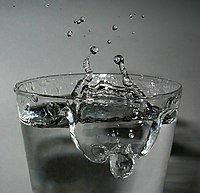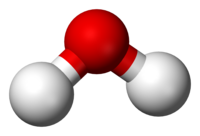User:Danish.Asif001/sandbox
A chemical compound is a chemical substance composed of many identical molecules (or molecular entities) composed of atoms from more than one element held together by chemical bonds. A molecule consisting of atoms of only one element is therefore not a compound.
There are four types of compounds, depending on how the constituent atoms are held together:
- molecules held together by covalent bonds
- ionic bonds
- metallic bonds
- certain complexes held together by coordinate covalent bonds.
A
A compound can be converted to a different chemical substance by interaction with a second substance via a chemical reaction. In this process, bonds between atoms may be broken in either or both of the interacting substances, and new bonds formed.
Definitions
Any substance consisting of two or more different types of
Chemical compounds have a unique and defined
There is varying and sometimes inconsistent nomenclature differentiating substances, which include truly non-stoichiometric examples, from chemical compounds, which require the fixed ratios. Many solid chemical substances—for example many silicate minerals—are chemical substances, but do not have simple formulae reflecting chemically bonding of elements to one another in fixed ratios; even so, these crystalline substances are often called "non-stoichiometric compounds". It may be argued that they are related to, rather than being chemical compounds, insofar as the variability in their compositions is often due to either the presence of foreign elements trapped within the crystal structure of an otherwise known true chemical compound, or due to perturbations in structure relative to the known compound that arise because of an excess of deficit of the constituent elements at places in its structure; such non-stoichiometric substances form most of the crust and mantle of the Earth. Other compounds regarded as chemically identical may have varying amounts of heavy or light isotopes of the constituent elements, which changes the ratio of elements by mass slightly.
Types
Molecules
A molecule is an
Ionic compounds
An ionic compound is a chemical compound composed of
4) and carbonate (CO2−
3) ions in ammonium carbonate. Individual ions within an ionic compound usually have multiple nearest neighbours, so are not considered to be part of molecules, but instead part of a continuous three-dimensional network, usually in a crystalline structure
Ionic compounds containing basic ions hydroxide (OH−) or oxide (O2−) are classified as bases. Ionic compounds without these ions are also known as salts and can be formed by acid–base reactions. Ionic compounds can also be produced from their constituent ions by evaporation of their solvent, precipitation, freezing, a solid-state reaction, or the electron transfer reaction of reactive metals with reactive non-metals, such as halogen gases.
Ionic compounds typically have high
Intermetallic compounds
An intermetallic compound is a type of metallic alloy that forms an ordered solid-state compound between two or more metallic elements. Intermetallics are generally hard and brittle, with good high-temperature mechanical properties.[14][15][16] They can be classified as stoichiometric or nonstoichiometic intermetallic compounds.[14]
Complexes
A coordination complex consists of a central atom or ion, which is usually metallic and is called the coordination centre, and a surrounding array of bound molecules or ions, that are in turn known as ligands or complexing agents.[17][18][19] Many metal-containing compounds, especially those of transition metals, are coordination complexes.[20] A coordination complex whose centre is a metal atom is called a metal complex of d block element.
Bonding and forces
Compounds are held together through a variety of different types of bonding and forces. The differences in the types of bonds in compounds differ based on the types of elements present in the compound.
A
Reactions
A compound can be converted to a different chemical composition by interaction with a second chemical compound via a chemical reaction. In this process, bonds between atoms are broken in both of the interacting compounds, and then bonds are reformed so that new associations are made between atoms. Schematically, this reaction could be described as AB + CD → AD + CB, where A, B, C, and D are each unique atoms; and AB, AD, CD, and CB are each unique compounds.
The Hill System
The Hill System or also known as the Hill Notation is a form of writing chemical formulas idea by Edwin A. Hill. It is used to set the order of the Carbon atom as first and Hydrogen atom as the second of a chemical formula. Ex. C12H22O11 If the following chemicals are not present, the chemical formula should be written in alphabetic order. Ex. AgCNO[27]
See also
- Chemical structure
- IUPAC nomenclature
- Dictionary of chemical formulas
- List of compounds
References
- PMID 31968937.
- ISBN 978-0-03-072373-5
- ISBN 9781442559462, archivedfrom the original on 2021-05-31, retrieved 2020-12-08
- ISBN 978-0-13-140283-6, archivedfrom the original on 2009-03-22
- ISBN 978-0-13-251210-7
- ^ "Chemical compound". ScienceDaily. Archived from the original on 2017-09-13. Retrieved 2017-09-13.
- ^ ISBN 978-0-7167-5701-6.
- ISBN 978-0-395-43302-7.
- ISBN 978-0-13-066997-1.
- ISBN 978-0-07-115221-1.
- ISBN 978-0-669-41794-4.
- ^ )
- from the original on 2021-05-31. Retrieved 2020-11-10.
- from the original on 2021-05-31. Retrieved 2020-11-10.
- ISBN 9780470687123.
- ISBN 978-0-08-037941-8.
- ^ "London Dispersion Forces". www.chem.purdue.edu. Archived from the original on 2017-01-13. Retrieved 2017-09-13.
- ^ "Ionic and Covalent Bonds". Chemistry LibreTexts. 2013-10-02. Archived from the original on 2017-09-13. Retrieved 2017-09-13.
- ^ "Hydrogen Bonds". chemistry.elmhurst.edu. Archived from the original on 2016-11-19. Retrieved 2017-10-28.
- ^ "Hydrogen Bonding". www.chem.purdue.edu. Archived from the original on 2011-08-08. Retrieved 2017-10-28.
- ^ "intermolecular bonding – hydrogen bonds". www.chemguide.co.uk. Archived from the original on 2016-12-19. Retrieved 2017-10-28.
- )
Further reading
- Robert Siegfried (2002), From elements to atoms: a history of chemical composition, American Philosophical Society, ISBN 978-0-87169-924-4



